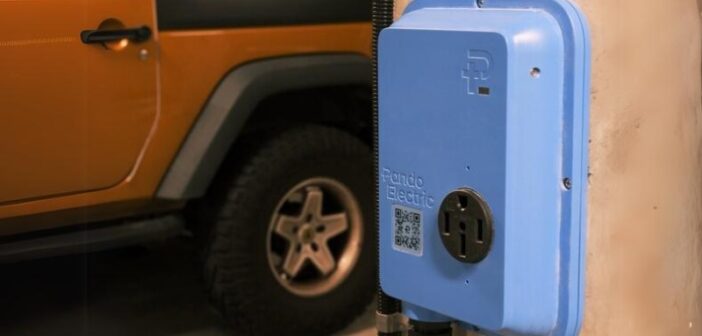Pando Electric is setting a new benchmark for EV charging in multi-family properties with a cost-effective solution that utilizes existing NEMA 14-50 sockets to reduce initial setup costs. The system includes compact, easy-to-install hardware for high-speed Level 2 charging and smart adaptive load management software to optimize electricity usage. Together, these features allow property owners to meet current EV charging needs while preparing their infrastructure for future expansion.
“Installing EV chargers in apartment and condominium buildings presents a range of challenges including infrastructure, installation costs, power capacity, space constraints and changing resident demand,” explains Aaron Li, Pando Electric’s Founder and CEO. “At Pando Electric, we have tackled each of these issues head-on, creating a straightforward, cost-effective and fully scalable solution.”
Installing high-speed charging at significant savings.
Pando Electric’s approach is rooted in simplicity, starting with a readily available power source; the company’s hardware utilizes NEMA 14-50 electrical sockets, already standard in most buildings. By leveraging existing electrical infrastructure, Pando Electric substantially cuts the need for expensive upfront upgrades.
While installation costs are reduced, Pando Electric delivers a high-speed, Level 2 charging experience without the bulky, intrusive hardware typical of public chargers. Rather, Pando Electric hardware is compact, much easier to install and substantially more affordable.
“Many of our multi-family property clients initially plan to install just one or two chargers,” Li continues. “However, once they see how affordable Pando Electric is, especially when paired with the incentives currently available, they often expand the scale of their initial installation.”
Optimizing power consumption across the grid.
Adaptive load management is another cornerstone for Pando Electric. Guided by pre-set priorities, this smart system dynamically allocates electricity demand across various Pando Electric outlets, expertly balancing energy consumption with driver needs.
“With our adaptive load management software, multiple Pando Electric sockets can seamlessly share power from a single electrical panel,” says Li. “This allows us to install up to ten times the number of outlets without any additional infrastructure costs.”
Pando Electric’s software offers additional benefits: preventing capacity overload; enabling smart metering; and automatically scaling back charging during peak electricity demand.
Providing near zero maintenance operation.
Through rigorous testing, Pando Electric chargers have demonstrated durability equivalent to 40 years of average daily usage. Coupled with Pando Electric’s bring-your-own-cable connection, eliminating the broken cord issue that plagues many public chargers, building managers are assured that adding more chargers does not equate to new maintenance workloads.
Li makes an analogy, “Most homes use NEMA 14-50 for connecting appliances like electric ranges and dryers. They’ll likely never need to be replaced; you can expect the same from Pando Electric outlets.”
Laying the groundwork for the future.
EVs are projected to account for over 40% of new car sales by 2030, according to BloombergNEF. To meet this growing demand, multi-family properties must rapidly expand their charging infrastructure.
“At Pando Electric, we’ve made it simpler and more cost-effective than ever to install EV chargers in apartment and condominium buildings,” says Li. “Our solutions are flexible, built with scalability in mind – ensuring your property is ready for the future as well.”
Related News:
More Than One Million Places for EV Drivers to Charge with ChargePoint

